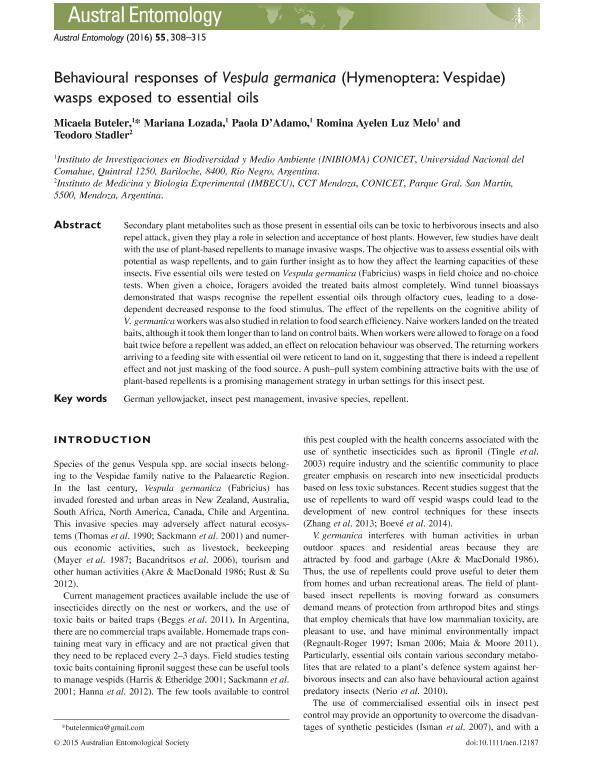Mostrar el registro sencillo del ítem
dc.contributor.author
Buteler, Micaela

dc.contributor.author
Lozada, Mariana

dc.contributor.author
D'adamo, Paola

dc.contributor.author
Melo, Romina Ayelén Luz

dc.contributor.author
Stadler, Teodoro

dc.date.available
2019-02-07T16:33:54Z
dc.date.issued
2015-12-01
dc.identifier.citation
Buteler, Micaela; Lozada, Mariana; D'adamo, Paola; Melo, Romina Ayelén Luz; Stadler, Teodoro; Behavioural responses of Vespula germanica (Hymenoptera: Vespidae) wasps exposed to essential oils; Blackwell Publishing; Austral Entomology; 55; 3; 1-12-2015; 308-315
dc.identifier.issn
2052-174X
dc.identifier.uri
http://hdl.handle.net/11336/69636
dc.description.abstract
Secondary plant metabolites such as those present in essential oils can be toxic to herbivorous insects and also repel attack, given they play a role in selection and acceptance of host plants. However, few studies have dealt with the use of plant-based repellents to manage invasive wasps. The objective was to assess essential oils with potential as wasp repellents, and to gain further insight as to how they affect the learning capacities of these insects. Five essential oils were tested on Vespula germanica (Fabricius) wasps in field choice and no-choice tests. When given a choice, foragers avoided the treated baits almost completely. Wind tunnel bioassays demonstrated that wasps recognise the repellent essential oils through olfactory cues, leading to a dose-dependent decreased response to the food stimulus. The effect of the repellents on the cognitive ability of V. germanica workers was also studied in relation to food search efficiency. Naive workers landed on the treated baits, although it took them longer than to land on control baits. When workers were allowed to forage on a food bait twice before a repellent was added, an effect on relocation behaviour was observed. The returning workers arriving to a feeding site with essential oil were reticent to land on it, suggesting that there is indeed a repellent effect and not just masking of the food source. A push–pull system combining attractive baits with the use of plant-based repellents is a promising management strategy in urban settings for this insect pest.
dc.format
application/pdf
dc.language.iso
eng
dc.publisher
Blackwell Publishing

dc.rights
info:eu-repo/semantics/openAccess
dc.rights.uri
https://creativecommons.org/licenses/by-nc-sa/2.5/ar/
dc.subject
German Yellowjacket
dc.subject
Insect Pest Management
dc.subject
Invasive Species
dc.subject
Repellent
dc.subject.classification
Otras Ciencias Biológicas

dc.subject.classification
Ciencias Biológicas

dc.subject.classification
CIENCIAS NATURALES Y EXACTAS

dc.title
Behavioural responses of Vespula germanica (Hymenoptera: Vespidae) wasps exposed to essential oils
dc.type
info:eu-repo/semantics/article
dc.type
info:ar-repo/semantics/artículo
dc.type
info:eu-repo/semantics/publishedVersion
dc.date.updated
2019-01-23T19:03:49Z
dc.identifier.eissn
2052-1758
dc.journal.volume
55
dc.journal.number
3
dc.journal.pagination
308-315
dc.journal.pais
Australia

dc.journal.ciudad
Melbourne
dc.description.fil
Fil: Buteler, Micaela. Consejo Nacional de Investigaciones Científicas y Técnicas. Centro Científico Tecnológico Conicet - Patagonia Norte. Instituto de Investigaciones en Biodiversidad y Medioambiente. Universidad Nacional del Comahue. Centro Regional Universidad Bariloche. Instituto de Investigaciones en Biodiversidad y Medioambiente; Argentina
dc.description.fil
Fil: Lozada, Mariana. Consejo Nacional de Investigaciones Científicas y Técnicas. Centro Científico Tecnológico Conicet - Patagonia Norte. Instituto de Investigaciones en Biodiversidad y Medioambiente. Universidad Nacional del Comahue. Centro Regional Universidad Bariloche. Instituto de Investigaciones en Biodiversidad y Medioambiente; Argentina
dc.description.fil
Fil: D'adamo, Paola. Consejo Nacional de Investigaciones Científicas y Técnicas. Centro Científico Tecnológico Conicet - Patagonia Norte. Instituto de Investigaciones en Biodiversidad y Medioambiente. Universidad Nacional del Comahue. Centro Regional Universidad Bariloche. Instituto de Investigaciones en Biodiversidad y Medioambiente; Argentina
dc.description.fil
Fil: Melo, Romina Ayelén Luz. Consejo Nacional de Investigaciones Científicas y Técnicas. Centro Científico Tecnológico Conicet - Patagonia Norte. Instituto de Investigaciones en Biodiversidad y Medioambiente. Universidad Nacional del Comahue. Centro Regional Universidad Bariloche. Instituto de Investigaciones en Biodiversidad y Medioambiente; Argentina
dc.description.fil
Fil: Stadler, Teodoro. Consejo Nacional de Investigaciones Científicas y Técnicas. Centro Científico Tecnológico Conicet - Mendoza. Instituto de Medicina y Biología Experimental de Cuyo; Argentina
dc.journal.title
Austral Entomology
dc.relation.alternativeid
info:eu-repo/semantics/altIdentifier/doi/http://dx.doi.org/10.1111/aen.12187
dc.relation.alternativeid
info:eu-repo/semantics/altIdentifier/url/https://onlinelibrary.wiley.com/doi/abs/10.1111/aen.12187
Archivos asociados
